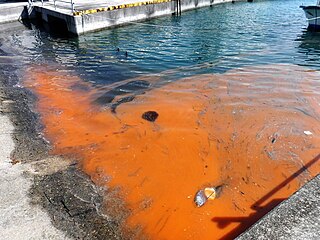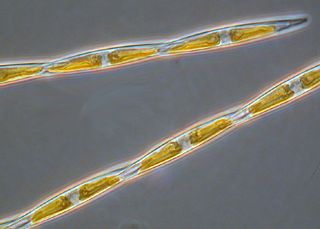Related Research Articles

A red tide is a phenomenon of discoloration of sea surface. It is a common name for harmful algal blooms occurring along coastal regions, which result from large concentrations of aquatic microorganisms, such as protozoans and unicellular algae . Terrestrial runoff, containing fertilizer, sewage and livestock wastes, transports abundant nutrients to the seawater and stimulates bloom events. Natural causes, such as river floods or upwelling of nutrients from the sea floor, often following massive storms, provide nutrients and trigger bloom events as well. Increasing coastal developments and aquaculture also contribute to the occurrence of red tides. Harmful algal blooms can occur worldwide, and natural cycles can vary regionally.

An algal bloom or algae bloom is a rapid increase or accumulation in the population of algae in freshwater or marine water systems. It is often recognized by the discoloration in the water from the algae's pigments. The term algae encompasses many types of aquatic photosynthetic organisms, both macroscopic multicellular organisms like seaweed and microscopic unicellular organisms like cyanobacteria. Algal bloom commonly refers to the rapid growth of microscopic unicellular algae, not macroscopic algae. An example of a macroscopic algal bloom is a kelp forest.

Domoic acid (DA) is a kainic acid-type neurotoxin that causes amnesic shellfish poisoning (ASP). It is produced by algae and accumulates in shellfish, sardines, and anchovies. When sea lions, otters, cetaceans, humans, and other predators eat contaminated animals, poisoning may result. Exposure to this compound affects the brain, causing seizures, and possibly death.
An exopolymer is a biopolymer that is secreted by an organism into the environment. These exopolymers include the biofilms produced by bacteria to anchor them and protect them from environmental conditions. One type of expolymer, Transparent Exopolymers (TEP), found in both marine and aquatic ecosystems, are planktonic acidic polysaccharides of a gel-like consistency, originally defined by their ability to be stained visible by acidic Alcian Blue. Their free-floating characteristic sets TEPs aside from other extracellular polymeric substance subgroups where exopolymers exists as cell coating, dissolved slime or as part of biofilm matrices.
Amnesic shellfish poisoning (ASP) is an illness caused by consumption of shellfish that contain the marine biotoxin called domoic acid. In mammals, including humans, domoic acid acts as a neurotoxin, causing permanent short-term memory loss, brain damage, and death in severe cases.

R/V Thomas G. Thompson (AGOR-23) is a Global-class research vessel owned by the United States Office of Naval Research and operated under a bareboat charterparty agreement by the University of Washington as part of the University-National Oceanographic Laboratory System (UNOLS) fleet.

Thin layers are concentrated aggregations of phytoplankton and zooplankton in coastal and offshore waters that are vertically compressed to thicknesses ranging from several centimeters up to a few meters and are horizontally extensive, sometimes for kilometers. Generally, thin layers have three basic criteria: 1) they must be horizontally and temporally persistent; 2) they must not exceed a critical threshold of vertical thickness; and 3) they must exceed a critical threshold of maximum concentration. The precise values for critical thresholds of thin layers has been debated for a long time due to the vast diversity of plankton, instrumentation, and environmental conditions. Thin layers have distinct biological, chemical, optical, and acoustical signatures which are difficult to measure with traditional sampling techniques such as nets and bottles. However, there has been a surge in studies of thin layers within the past two decades due to major advances in technology and instrumentation. Phytoplankton are often measured by optical instruments that can detect fluorescence such as LIDAR, and zooplankton are often measured by acoustic instruments that can detect acoustic backscattering such as ABS. These extraordinary concentrations of plankton have important implications for many aspects of marine ecology, as well as for ocean optics and acoustics. It is important to note that zooplankton thin layers are often found slightly under phytoplankton layers because many feed on them. Thin layers occur in a wide variety of ocean environments, including estuaries, coastal shelves, fjords, bays, and the open ocean, and they are often associated with some form of vertical structure in the water column, such as pycnoclines, and in zones of reduced flow.

A harmful algal bloom (HAB) contains organisms that can severely lower oxygen levels in natural waters, killing organisms in marine or fresh waters. Some HABs are associated with algae-produced toxins. Blooms can last from a few days to many months. After the bloom dies, the microbes that decompose the dead algae use up even more of the oxygen, which can cause fish die-offs. When these zones of depleted oxygen cover a large area for an extended period of time, neither fish nor plants are able to survive.

The Continuous Plankton Recorder (CPR) Survey is one of the longest running marine biological monitoring programmes in the world. Started in 1931 by Sir Alister Hardy and Sir Cyril Lucas, the Survey provides marine scientists and policy-makers with measures of plankton communities, coupled with ocean physical, biological and chemical observations, on a pan-oceanic scale. The Survey is a globally recognised leader on the impacts of environmental change on the health of our oceans.

Pseudo-nitzschia is a marine planktonic diatom genus that accounts for 4.4% of pennate diatoms found worldwide. Some species are capable of producing the neurotoxin domoic acid (DA), which is responsible for the neurological disorder in humans known as amnesic shellfish poisoning (ASP). Currently, 59 species are known, 28 of which have been shown to produced DA. It was originally hypothesized that only dinoflagellates could produce harmful algal toxins, but a deadly bloom of Pseudo-nitzschia occurred in 1987 in the bays of Prince Edward Island, Canada, and led to an outbreak of ASP. Over 100 people were affected by this outbreak after consuming contaminated mussels; three people died. Since this event, no additional deaths have been attributed to ASP, though the prevalence of toxic diatoms and DA has increased worldwide. This anomaly is likely due to increased awareness of harmful algal blooms (HABs) and their implications for human and ecosystem health.

The Harmful Algal Bloom and Hypoxia Research and Control Amendments Act of 2014 is a U.S. public law that reauthorizes and modifies the Harmful Algal Bloom and Hypoxia Research and Control Act of 1998 and would authorize the appropriation of $20.5 million annually through 2018 for the National Oceanic and Atmospheric Administration (NOAA) to mitigate the harmful effects of algal blooms and hypoxia.

The Quinault Canyon is a submarine canyon, off Washington state, in Olympic Coast National Marine Sanctuary.
Pseudo-nitzschia australis is a pennate diatom found in temperate and sub-tropic marine waters, such as off the coast of California and Argentina. This diatom is a Harmful Micro Algae that produces toxic effects on a variety of organisms through its production of domoic acid, a neurotoxin. Toxic effects have been observed in a variety of predatory organisms such as pelicans, sea lions, and humans. If exposed to a high enough dose, these predators will die as a result, and there is no known antidote. The potential indirect mortality associated with P. australis is of great concern to humans as toxic algae blooms, including blooms of P. australis, continue to increase in frequency and severity over recent years. Blooms of P. australis are believed to result from high concentrations of nitrates and phosphates in stream and river runoff, as well as coastal upwelling, which are also sources of other harmful algae blooms.
A marine heatwave (MHW) is a short period of abnormally high temperatures in a sea or ocean. Marine heatwaves are caused by a variety of factors and have been associated with severe biodiversity changes such as sea star wasting disease, toxic algal blooms, and mass mortality of benthic communities.
Collin Roesler is an American oceanographer. She is known for her work on optical oceanography, including research on harmful algal blooms in the Gulf of Maine and green icebergs.
Transparent exopolymer particles (TEPs) are extracellular acidic polysaccharides produced by phytoplankton and bacteria in saltwater, freshwater, and wastewater. They are incredibly abundant and play a significant role in biogeochemical cycling of carbon and other elements in water. Through this, they also play a role in the structure of food webs and trophic levels. TEP production and overall concentration has been observed to be higher in the Pacific Ocean compared to the Atlantic, and is more related to solar radiation in the Pacific. TEP concentration has been found to decrease with depth, having the highest concentration at the surface, especially associated with the SML, either by upward flux or sea surface production. Chlorophyll a has been found to be the best indicator of TEP concentration, rather than heterotrophic grazing abundance, further emphasizing the role of phytoplankton in TEP production. TEP concentration is especially enhanced by haptophyte phytoplanktonic dominance, solar radiation exposure, and close proximity to sea ice. TEPs also do not seem to show any diel cycles. High concentrations of TEPs in the surface ocean slow the sinking of solid particle aggregations, prolonging pelagic residence time. TEPs may provide an upward flux of materials such as bacteria, phytoplankton, carbon, and trace nutrients. High TEP concentrations were found under arctic sea ice, probably released by sympagic algae. TEP is efficiently recycled in the ocean, as heterotrophic grazers such as zooplankton and protists consume TEP and produce new TEP precursors to be reused, further emphasizing the importance of TEPs in marine carbon cycling. TEP abundance tends to be higher in coastal, shallow waters compared to deeper, oceanic waters. Diatom-dominated phytoplankton colonies produce larger, and stickier, TEPs, which may indicate that TEP size distribution and composition may be a useful tool in determining aggregate planktonic community structure.
Patricia Marguerite Glibert is marine scientist known for her research on nutrient use by phytoplankton and harmful algal blooms in Chesapeake Bay. She is an elected fellow of the American Association for the Advancement of Science.

Ana María Gayoso was an Argentine marine biologist, a specialist in study of marine phytoplankton, best known for being the first scientist to describe phytoplankton in the Bahía Blanca Estuary, and to initiate the sustained long-term oceanographic dataset in this ecosystem. She made significant contributions to the understanding of harmful algal blooms caused by toxic dinoflagellate species in the Patagonian gulfs, and was the first scientist to describe high abundances of the coccolithophore Emiliania huxleyi in the Argentine Sea, a key component in the primary productivity along the Patagonian Shelf Break front in the SW South Atlantic. She started the most extensive (1978-present) long-term database of phytoplankton and physico-chemical variables in South America, in a fixed monitoring site in the Bahía Blanca Estuary. She died on 28 December 2004 in Puerto Madryn.
Colleen Beckman Mouw is an associate professor at the University of Rhode Island known for her work on phytoplankton ecology and increasing retention of women in oceanography.
Evelyn Lessard is a biological oceanographer and a professor at the University of Washington's School of Oceanography.
References
| Scholia has an author profile for Barbara Hickey . |
- ↑ "Ann Gargett". MPOWIR. 2010-08-12. 120. Archived from the original on 2012-10-18. Retrieved 2020-02-09.
- 1 2 3 Delaney, Peggy (2005). "Women in Oceanography" (PDF). The Oceanography Society. Archived (PDF) from the original on 2021-05-17. Retrieved 2020-02-08.
- ↑ "Barbara Hickey". College of the Environment. Retrieved 2020-02-08.
- 1 2 "Barbara Hickey, AGU Fellow". www.ocean.washington.edu. Retrieved 2020-02-08.
- ↑ Hickey, B. M.; Kudela, R. M.; Nash, J. D.; Bruland, K. W.; Peterson, W. T.; MacCready, P.; Lessard, E. J.; Jay, D. A.; Banas, N. S.; Baptista, A. M.; Dever, E. P. (2010-02-03). "River Influences on Shelf Ecosystems: Introduction and synthesis". Journal of Geophysical Research. 115 (C2): C00B17. Bibcode:2010JGRC..115.0B17H. doi: 10.1029/2009JC005452 . ISSN 0148-0227.
- ↑ "Project: ECOHAB - Pacific Northwest | BCO-DMO". www.bco-dmo.org. Retrieved 2020-02-08.
- ↑ "NSF Award Search: Award#0234587 - ECOHAB PNW: Ecology and Oceanography of Toxic Pseudo-nitzschia in the Pacific Northwest Coastal Ocean". www.nsf.gov. Retrieved 2020-02-08.
- ↑ "Cascadia Simulations PNWTOX - Pacific NorthWest TOXins project". iodlabs.ucsd.edu. Retrieved 2020-02-08.
- ↑ "UW researcher helping pinpoint massive harmful algal bloom". UW News. Retrieved 2020-02-08.
- ↑ "Ocean conditions contributed to unprecedented 2015 toxic algal bloom". UW News. Retrieved 2020-02-08.
- ↑ "Barbara Hickey Hickey Barbara A1". photos.aip.org. 2014-02-24. Retrieved 2020-02-08.
- ↑ "List of Fellows". American Meteorological Society. Retrieved 2020-02-08.
- ↑ "Women in Oceanography: A Decade Later" (PDF). The Oceanography Society. 2014. Archived (PDF) from the original on 2016-08-20. Retrieved 2020-02-08.